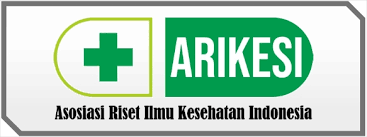Mathematical Simulation Analysis of Body Temperature Observations Covid-19 Patients
Abstract
Keywords
Full Text:
PDFReferences
Achlison U. 2020. Implementation Analysis. Human Body Temperature Measurement in the Covid-19 Pandemic in Indonesia. Pixel :Scientific Journal of Computer Graphics. https://doi.org/10.51903/pixel.v13i2.318
Amalia, H. (2021). Omicron causes COVID-19 as a variant of concern. Journal of Biomedics And Health. https://doi.org/10.18051/jbiomedkes.2021.v4.139-141
Bates, J. T., Pennington, A. F., Zhai, X., Friberg, M. D., Metcalf, F., Darrow, L., … Russell, A. (2018). Application and evaluation of two model fusion approaches to obtain ambient air pollutant concentrations at a fine spatial resolution (250m) in Atlanta. Environmental Modelling and Software. https://doi.org/10.1016/j.envsoft.2018.06.008
Carrier, M., Apparicio, P., Séguin, A. M., & Crouse, D. (2014). The application of three methods to measure the statistical association between different social groups and the concentration of air pollutants in Montreal: A case of environmental equity. Transportation Research Part D: Transport and Environment. https://doi.org/10.1016/j.trd.2014.05.001
Chalik, 2016. (2016). Physiological Anatomy of MAnusia, Ministry of Health of the Republic of Indonesia. Ministry of Health of the Republic of Indonesia
Coudon, T., Hourani, H., Nguyen, C., Faure, E., Mancini, F. R., Fervers, B., & Salizzoni, P. (2018). Assessment of long-term exposure to airborne dioxin and cadmium concentrations in the Lyon metropolitan area (France). Environment International. https://doi.org/10.1016/j.envint.2017.11.027
Dash, A. K., Sahu, S. K., Pradhan, A., Dash, S. K., & Kolli, R. N. (2017). Air dispersion model to study the point source air pollution and its impact on ambient air quality. Asian Journal of Chemistry. https://doi.org/10.14233/ajchem.2017.20477
Ding, F. M., Feng, Y., Han, L., Zhou, Y., Ji, Y., Hao, H. J., … Zhang, M. (2021). Early Fever Is Associated With Clinical Outcomes in Patients With Coronavirus Disease. Frontiers in Public Health, 9(August). https://doi.org/10.3389/fpubh.2021.712190
dos Santos, L. H. M., Kerr, A. A. F. S., Veríssimo, T. G., Andrade, M. de F., de Miranda, R. M., Fornaro, A., & Saldiva, P. (2014). Analysis of atmospheric aerosol (PM2.5) in Recife city, Brazil. Journal of the Air and Waste Management Association. https://doi.org/10.1080/10962247.2013.854282
Fallah-Shorshani, M., Shekarrizfard, M., & Hatzopoulou, M. (2017). Integrating a street-canyon model with a regional Gaussian dispersion model for improved characterisation of near-road air pollution. Atmospheric Environment. https://doi.org/10.1016/j.atmosenv.2017.01.006
Gallagher, J., & Lago, C. (2019). How parked cars affect pollutant dispersion at street level in an urban street canyon? A CFD modelling exercise assessing geometrical detailing and pollutant decay rates. Science of the Total Environment. https://doi.org/10.1016/j.scitotenv.2018.10.135
Gul, M. H., Htun, Z. M., & Inayat, A. (2021). Role of fever and ambient temperature in COVID-19. Expert Review of Respiratory Medicine, 15(2), 171–173. https://doi.org/10.1080/17476348.2020.1816172
He, B., Heal, M. R., & Reis, S. (2018). Land-use regression modelling of intra-urban air pollution variation in China: Current status and future needs. Atmosphere. https://doi.org/10.3390/atmos9040134
Hendry, J., Sumanto, B., Prayoga, B. T., Budiani, R. L., Lestari, R. A., Yuda, P. P., & Nugroho, A. A. (2021). Prototype of Wearable Glasses for Body Temperature Monitoring for COVID-19 Mitigation. Journal of Physics: Conference Series, 1844(1). https://doi.org/10.1088/1742-6596/1844/1/012014
Hennig, F., Sugiri, D., Tzivian, L., Fuks, K., Moebus, S., Jöckel, K. H., … Hoffmann, B. (2016). Comparison of land-use regression modeling with dispersion and chemistry transport modeling to assign air pollution concentrations within the Ruhr area. Atmosphere. https://doi.org/10.3390/atmos7030048
Jayusman, I., & Shavab, O. A. K. (2020). Student Learning Activities Using Edmodo-Based Learning Management System (LMS) Learning Media in History Learning. Journal of Artifacts, 7(1), 13. https://doi.org/10.25157/ja.v7i1.3180
Karyono, K., Rohadin, R., & Indriyani, D. (2020). HANDLING AND PREVENTION OF THE CORONAVIRUS (COVID-19) PANDEMIC IN INDRAMAYU REGENCY. Journal of Conflict Resolution Collaboration. https://doi.org/10.24198/jkrk.v2i2.29127
Ministry of Health of the Republic of Indonesia. (2020). August 2020 COVID-19 MANAGEMENT GUIDELINES. Retrieved from https://www.papdi.or.id/pdfs/938/Pedoman COVID-19 Management 2nd edition.pdf
Lau, S. K. P., Woo, P. C. Y., Wong, B. H. L., Tsoi, H. W., Woo, G. K. S., Poon, R. W. S., Chan, K. H., Wei, W. I., Malik Peiris, J. S., & Yuen, K. Y. (2004). Detection of severe acute respiratory syndrome (SARS) coronavirus nucleocapsid protein in SARS patients by enzyme-linked immunosorbent assay. Journal of Clinical Microbiology. https://doi.org/10.1128/JCM.42.7.2884-2889.2004
Merico, E., Dinoi, A., & Contini, D. (2019). Development of an integrated modelling-measurement system for near-real-time estimates of harbour activity impact to atmospheric pollution in coastal cities. Transportation Research Part D: Transport and Environment. https://doi.org/10.1016/j.trd.2019.06.009
Morakinyo, T. E., Lam, Y. F., & Hao, S. (2016). Evaluating the role of green infrastructures on near-road pollutant dispersion and removal: Modelling and measurement. Journal of Environmental Management. https://doi.org/10.1016/j.jenvman.2016.07.077
Moreira, D. M., & dos Santos, C. A. G. (2019). New approach to handle gas-particle transformation in air pollution modelling using fractional derivatives. Atmospheric Pollution Research. https://doi.org/10.1016/j.apr.2019.05.006
Nyberg, T., Ferguson, N. M., Nash, S. G., Webster, H. H., Flaxman, S., Andrews, N., Hinsley, W., Bernal, J. L., Kall, M., Bhatt, S., Blomquist, P. B., Zaidi, A., Volz, E., Abdul Aziz, N., Harman, K., Hope, R., Charlett, A., Chand, M. A., Ghani, A., … Thelwall, S. (2022). Comparative Analysis of the Risks of Hospitalisation and Death Associated with SARS-CoV-2 Omicron (B.1.1.529) and Delta (B.1.617.2) Variants in England. SSRN Electronic Journal. https://doi.org/10.2139/ssrn.4025932
Unang Achlison. (2020a). Analisis Implementasi Pengukuran Suhu Tubuh Manusia dalam Pandemi Covid-19 di Indonesia. Pixel :Jurnal Ilmiah Komputer Grafis. https://doi.org/10.51903/pixel.v13i2.318
Unang Achlison. (2020b). Analisis Implementasi Pengukuran Suhu Tubuh Manusia dalam Pandemi Covid-19 di Indonesia. Pixel :Jurnal Ilmiah Komputer Grafis, 13(2), 102–106. https://doi.org/10.51903/pixel.v13i2.318
VERMA, S., ABBAS, M., VERMA, S., KHAN, A., RIZVI, A. A., & MAHDI, F. (2021). Effectiveness of Blood Pressure and Body Temperature Screening for Severity in COVID-19 Patients. Journal of Microbiology and Infectious Diseases, October, 147–151. https://doi.org/10.5799/jmid.993892
Vicente, B., Rafael, S., Rodrigues, V., Relvas, H., Vilaça, M., Teixeira, J., … Borrego, C. (2018). Influence of different complexity levels of road traffic models on air quality modelling at street scale. Air Quality, Atmosphere and Health. https://doi.org/10.1007/s11869-018-0621-1
Wright, W. F., & MacKowiak, P. A. (2021). Why Temperature Screening for Coronavirus Disease 2019 with Noncontact Infrared Thermometers Does Not Work. Open Forum Infectious Diseases, 8(1), 4–6. https://doi.org/10.1093/ofid/ofaa603
Yuan, C., Shan, R., Zhang, Y., Li, X. X., Yin, T., Hang, J., & Norford, L. (2019). Multilayer urban canopy modelling and mapping for traffic pollutant dispersion at high density urban areas. Science of the Total Environment. https://doi.org/10.1016/j.scitotenv.2018.07.409
DOI: http://dx.doi.org/10.30742/jikw.v12i1.2179
Refbacks
- There are currently no refbacks.
Copyright (c) 2023 Ayly Soekanto, Emillia Devi Dwi Rianti, Endrayana Putut Laksminto Emanuel

This work is licensed under a Creative Commons Attribution-NonCommercial 4.0 International License.
Jurnal Ilmiah Kedokteran Wijaya Kusuma is licensed under a Creative Commons Attribution-NonCommercial 4.0 International License










